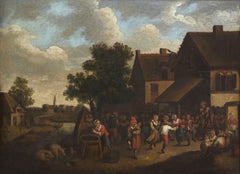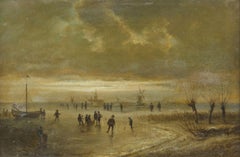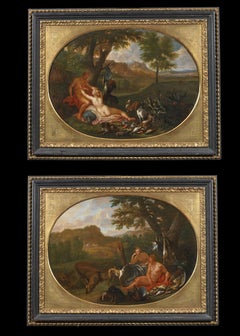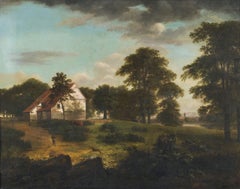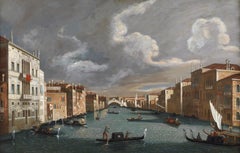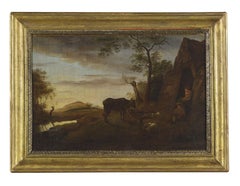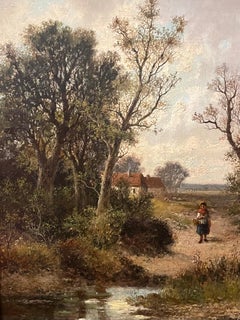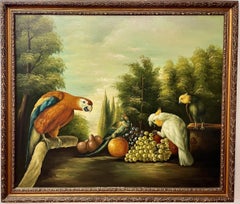Riccardo Moneghini Landscape Paintings
to
1
1
2
2
1
Overall Width
to
Overall Height
to
6
5
1
5
1
5
2
2
2
1
1
1
1
1
1
1
6
6
6
6
6
6
18th Century Landscape Flemish Scool Outdoor Peasant Oil on Canvas Brown Blue
Located in Sanremo, IT
Painting oil on canvas measuring 45 x 55 cm without frame and 65 x 75 cm with frame depicting an outdoor peasant scene from the Flemish school of the late 17th and early 18th centur...
Category
1690s Flemish School Landscape Paintings
Materials
Canvas, Oil
18th Century Winter Landscape Flemish School Snow Nature Oil on Canvas White
Located in Sanremo, IT
Painting, oil on canvas, measuring 55 x 35 cm without frame and 66 x 46 cm with a non-coeval frame, initialled at lower left in an unreadable manner, of the Flemish school.
The main...
Category
Late 18th Century Flemish School Landscape Paintings
Materials
Canvas, Oil
18th Century Galanti Scenes Van Limborch Rest Hunting Oil on Canvas Green Red
Located in Sanremo, IT
Pair of oval paintings measuring 66 x 89 cm without frame and 90 x 115 cm with coeval frame depicting two gallant moments during a rest from hunting by painter Hendrik Van Limborch (...
Category
1730s Old Masters Landscape Paintings
Materials
Canvas, Oil
18th Century Landscape Flemish School Nature Oil on Canvas Green White Brown
Located in Sanremo, IT
Painting oil on canvas with dimensions of 110 x 125 without frame and 120 x 135 cm with frame depicting a landscape en plen air case and characters immersed in the nature of the seco...
Category
Late 18th Century Landscape Paintings
Materials
Canvas, Oil
18th Century Venice Jacopo Fabris Venice Rialto Bridge Oil on Canvas Blue
Located in Sanremo, IT
Painting oil on canvas measuring 70 x 90 cm without frame and 82 x 102 cm with frame depicting View of the Grand Canal with the Rialto Bridge.
The work under examination depicting a...
Category
Mid-18th Century Italian School Landscape Paintings
Materials
Canvas, Oil
18th Century Landscape Flemish School People and Cows Oil on Canvas Green
Located in Sanremo, IT
Flemish painting measuring 44 x 30 cm without frame and 53 x 39 cm with frame depicting a landscape with figures, in soft tones and with a strong sense of perspective; elegant, fluid...
Category
18th Century Flemish School Landscape Paintings
Materials
Canvas, Oil
$2,645 Sale Price
20% Off
Related Items
Landscape Near Felday, Surrey
By Abraham Hulk the Younger
Located in Hillsborough, NC
Dutch/English artist Abraham Hulk the Younger (1851-1922) is most known for landscapes of the British countryside. This work is one of a pair (the second work is also available by s...
Category
Late 19th Century Old Masters Landscape Paintings
Materials
Canvas, Oil
$2,240 Sale Price
20% Off
H 27 in W 22.75 in D 2.13 in
After Pieter Casteels III (1684-1749), Timeless, Exotic Birds & Fruits
Located in San Francisco, CA
There was a time, before photography, before airplanes, a time when multi-masted wooden ships carried wonderous things to ports throughout Northern Europe. Then, a faithful rendering...
Category
Late 20th Century Flemish School Animal Paintings
Materials
Canvas, Oil
$1,250
H 36.75 in W 42.75 in D 2 in
Figures Chatting outside Village Tavern in Mountain Landscape, Period Oil
By 19th century Dutch or Flemish school
Located in Cirencester, Gloucestershire
Dutch/ Flemish School, early 1800's
oil on canvas, framed
framed: 19 x 24 inches
canvas: 13.5 x 18.5 inches
provenance: private collection, France
condition: good and sound condition...
Category
Early 19th Century Old Masters Landscape Paintings
Materials
Oil, Canvas
Large Pointillism Oil Painting Flower Seller and Cart Henry Benson Americana Art
By Henry Benson
Located in Surfside, FL
Flower Seller
Textured Oil on Canvas
Hand signed lower right
Image: H 30 x W 40 inches
Beautiful muted pastel tone colors
This depicts a boy and girl playing in the sand with a buck...
Category
20th Century Post-Impressionist Figurative Paintings
Materials
Canvas, Oil
17th Century by Felice Torelli Hagar and the Angel Oil on Canvas
Located in Milano, Lombardia
Felice Torelli (Verona, Italy, 1667 - Bologna, Italy, 1748)
Title: Hagar and the Angel
Medium: Oil on canvas
Dimensions: without frame 41 x 116 cm - wit...
Category
Late 17th Century Old Masters Landscape Paintings
Materials
Cotton Canvas, Canvas, Oil
$17,915 Sale Price
20% Off
H 20.67 in W 50.01 in D 1.97 in
Saint Francis Receiving the Stigmata
Oil on copper, Flemish school, 17th century
Located in Firenze, IT
Saint Francis Receiving the Stigmata
Oil on copper, Flemish school, 17th century
Dimensions: with frame 19 cm x 16 cm, without frame 16 cm x 13 cm
The scene of Saint Francis receivi...
Category
17th Century Flemish School Landscape Paintings
Materials
Copper
$800
H 7.49 in W 6.3 in
VENICE - In the Manner of Canaletto -Italian Landscape Oil on Canvas Painting
By Mario De Angeli
Located in Napoli, IT
Venice - Mario De Angeli - Italia 2008 - Oil on canvas cm. 75x150.
Mario De Angeli's canvas is an extraordinary work of Italian landscape painting.
They are inspired by the landsc...
Category
Early 2000s Italian School Landscape Paintings
Materials
Gold Leaf
$10,158
H 29.53 in W 59.06 in
SCREEN OF YELLOW LIGHT
Located in CÓRDOBA, ES
OIL ON FIBERBOARD.
by artist GRIGORIY IVANOV.
Grigoriy Ivanov is the founder of a new trend in the art named "Svetism" (Power of Light). The main idea of "Svetism" is the perception ...
Category
2010s Abstract Abstract Paintings
Materials
Canvas, Oil
Scandinavian Winter Sun
By Edvard Rosenberg
Located in Wiscasett, ME
Oil on canvas, signed lower left. A luminous sunset or sunrise winter scene from Scandinavia. Edvard Axel Rosenberg (Swedish School, 1858-1934) In many ways Edward Rosenberg...
Category
1910s Flemish School Landscape Paintings
Materials
Oil
Early 18th-Century Flemish School, Christ On The Cross With Mary Magdalene
Located in Cheltenham, GB
This early 18th-century Flemish oil painting depicts Christ on the cross with a sorrowful Mary Magdalene and Jerusalem beyond.
Head bloodied by a crown of thorns, arms taut and wrac...
Category
1720s Flemish School Figurative Paintings
Materials
Oil, Canvas
$2,239
H 34 in W 22 in
Polzeath, surf, Original painting, landscape
By Rupert Aker
Located in Deddington, GB
Waves crashing in on the rocks at Polzeath
Oil Paint on Canvas
18 H x 23 W x 3 D cm (7.09 x 9.06 x 1.18 in)
Sold framed
Image size:
Height: 15cm (5.91 in)
Width: 20cm (7.87 in)
Co...
Category
2010s Impressionist Paintings
Materials
Oil, Canvas
Shepherd with Sheep, Cows and a Goat in a Landscape by Jan Frans Soolmaker
Located in Stockholm, SE
This painting depicts a pastoral scene that is attributed to the artist Jan Frans Soolmaker, an artist known for his Italianate landscapes and scenes that often feature equestrian and Arcadian elements. The painting is not signed but is attributed to Soolmaker, relating it to a known signed work by the artist that was sold at Sotheby’s London in 1999.
The scene is suffused with the warm glow of a setting or rising sun, casting a soft light that is characteristic of Soolmaker’s landscapes. It shows a shepherd guiding a group of cattle across a shallow stream, with the animals taking center stage in the composition. The animals are rendered with careful attention to their forms and the play of light on their bodies, which is a hallmark of Soolmaker's work. The landscape is composed of a rocky terrain with trees and shrubbery, creating a sense of depth and natural beauty that invites the viewer to explore the scene further.
The background suggests a vast, open landscape with distant mountains, which adds to the Italianate feel of the painting. The sky is dramatic, with clouds catching the light of the sun, contributing to the overall serene yet dynamic atmosphere of the work.
The provenance of the painting is notable, having been in the possession of significant historical figures such as Swedish Prince Fredrik Adolf, and later The collection of Pär Ulmgren, The collection of Gösta Stenman, and Engineer and politician Gustaf Henry Hansson.
Potential buyers have the option of choosing between a newly made gold frame or an older brown frame, which allows for personalization in how the work is presented.
Soolmaker’s work is often compared to that of Dutch painter Nicolaes Berchem, whose style he emulated. Soolmaker's landscapes reflect a similar sensitivity to light and composition, making his works sought after for their beauty and historical significance. Despite the smaller body of work left by Soolmaker, due to his short career, his paintings are valued for their craftsmanship and the legacy of the artist’s brief but impactful contribution to the Dutch Italianate landscape genre.
Information:
Jan Frans Soolmaker (Flanders 1635‑1685)
Shepherd with Sheep...
Category
17th Century Old Masters Animal Paintings
Materials
Canvas, Oil
$4,252 Sale Price
20% Off
H 22.05 in W 20.87 in
